Authentic Italian tomato sauce - Make from scratch one of the best pasta sauces in the world with just 5 ingredients.
Homemade Italian tomato sauce is as tasty as it is easy to make, and it's the foundation of so many traditional Italian dishes.
Loved by kids and grown-ups, this classic pasta sauce is the most popular sauce in Italy.
It's actually one of the 5 mother sauces in the culinary arts, which are the bases for all the other ones.
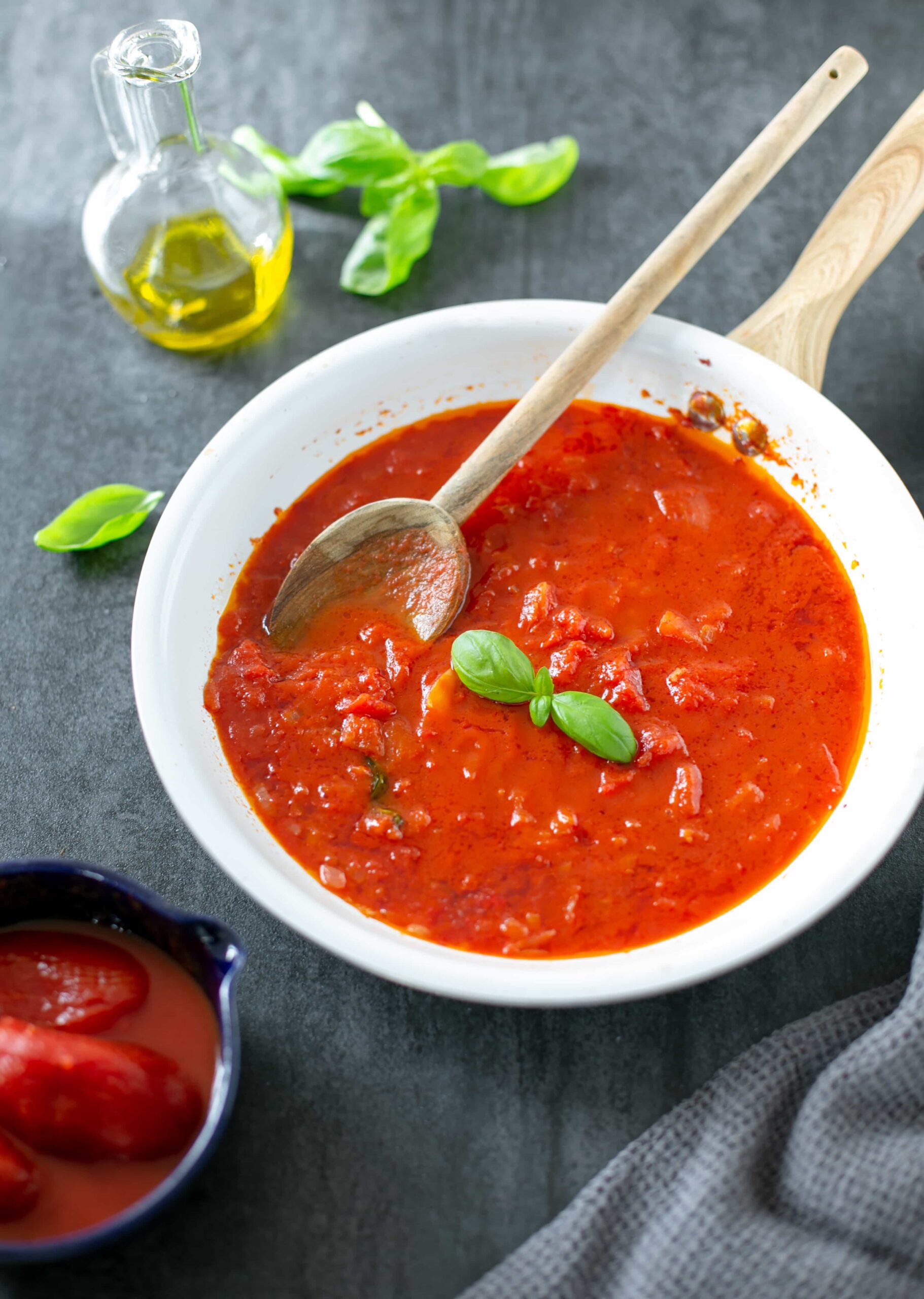
What the world calls pasta sauce, in Italian, we call it "salsa al pomodoro" or "sugo al pomodoro".
Growing up in an Italian kitchen, my mum would prepare it at least 3-to 4 times a week, so for me making this sauce is really easy.
However, I know it's not the case for a lot of people out there.
Some people add a generous amount of sugar, others use tomato puree or passata, and I've actually seen a few friends adding ketchup (WHAT?!).
Believe me, if you're looking for an authentic Italian recipe you don't need any of the above.
Jump to:
ITALIAN TOMATO SAUCE INGREDIENTS
If you're looking for the most authentic Italian tomato pasta sauce, this is the right place.
All you need is just 5 ingredients:
- Canned whole peeled tomatoes (or fresh tomatoes): For best results use San Marzano tomatoes. Scroll down for more info.
- Red onion: red onion adds sweetness and flavor to the sauce. You cna replace it with garlic or use both.
- Basil leaves: fresh basil leaves are also a key ingredient, so don't replace them with dried basil leaves.
- Bay leaf: this is the secret ingredient that takes the bitterness away from tomato sauce. No need to add sugar!
- Extra-virgin olive oil: I like to use single-origin Italian extra-virgin olive oil. However, any good quality EVOO will work!
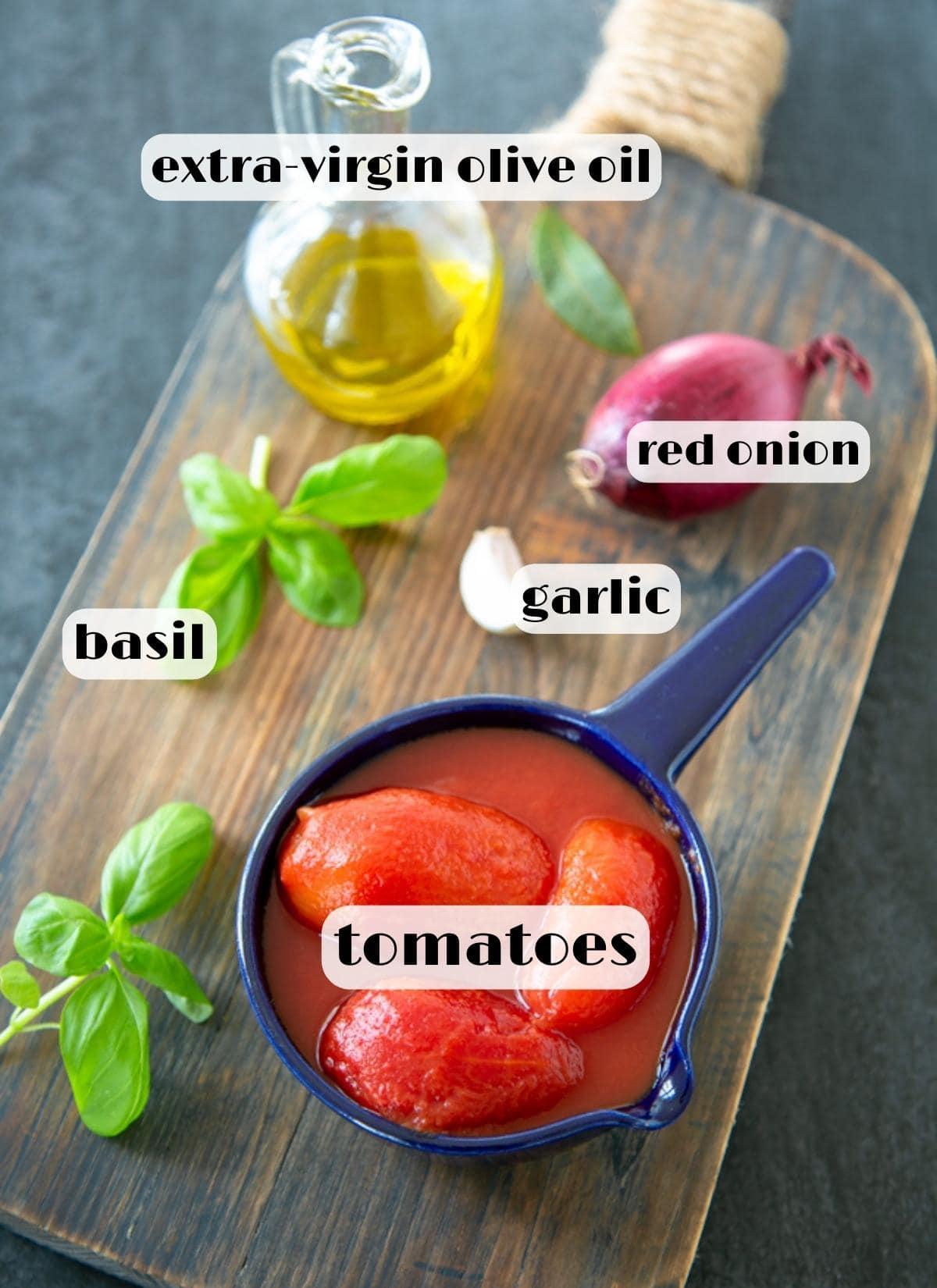
Most Italian mammas and nonnas add a garlic clove. My Italian mum adds it, and I often do that as well.
But it's totally optional, so if you're not a garlic fan, simply omit it. For a milder flavor, add it whole and discard it before serving.
Using the right ingredients is crucial for making the best tomato sauce.
Opt for organic ingredients whenever possible, don't skip on the fresh basil leaves, and use high-quality extra-virgin olive oil.
MARINARA VS TOMATO SAUCE
First of all, let's start by saying that there's a huge difference between these two famous sauces.
Marinara sauce is not cooked, and dried oregano is usually added into the mix.
It's often called pizza sauce, because, guess what, it's used for making Naepolitan pizza.
Tomato sauce, on the other hand, is slowly simmered, and onion, basil leaves and a bay leaf are usually added in.
It's used as a base for pasta, eggplant parmesan, meatballs, eggs in purgatory, and many other dishes.
FRESH OR CANNED TOMATOES?
To make Italian tomato sauce from fresh tomatoes (which I highly recommend when they're in season), there are a couple of extra steps to make.
- Blanch the tomatoes in simmering water for a couple of minutes.
- Peel the skin off and proceed with step 1 of the recipe.
This version of the recipe using fresh tomatoes is basically the famous Napoletana sauce.
The best fresh tomatoes to use are:
- Roma tomatoes: meaty, easy to peel, and with very few seeds.
- Cherry Tomatoes (ciliegino): they are small, round and really sweet.
- Datterino Tomatoes: also called mini Piccadilly tomatoes, they are small and delicately sweet.
It's not easy to find super tasty tomatoes these days, especially if you don't live in Italy. So I mostly use properly-good canned whole tomatoes.
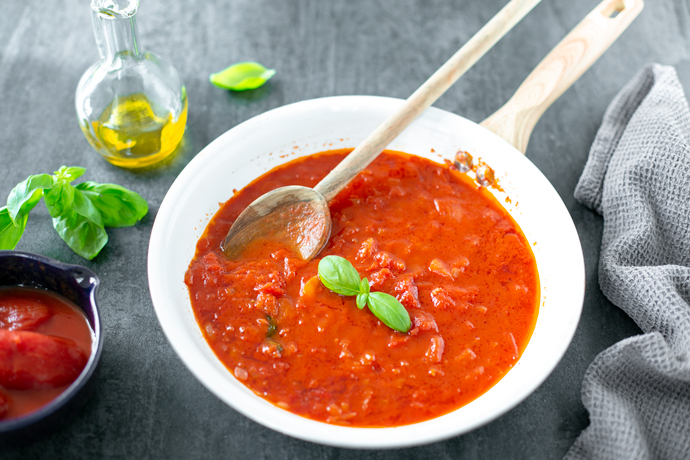
If you're opting for canned tomatoes, the best ones to look for is the San Marzano variety.
This variety grows in Italy, in the Campania region, and has been awarded the PDO (protected designation of origin) status.
San Marzano tomatoes have a long shape, bright red colour, easily peelable skin, meaty pulp, and very few seeds.
Their flavour is not too sweet and not too bitter, which makes them incredibly versatile, both for cooking and using them raw.
These are the very best tomatoes to use for making tomato sauce, or the classic marinara sauce for Neapolitan pizza.
ITALIAN RECIPE FOR TOMATO SAUCE
This recipe takes a pinch of patience to make, but it's definitely worth it.
The secret lies in slowly simmering the ingredients for about 20 minutes.
They will slowly turn into a rich, creamy tomato sauce with a bit of chunky texture, and the right balance of sweetness and savoury.
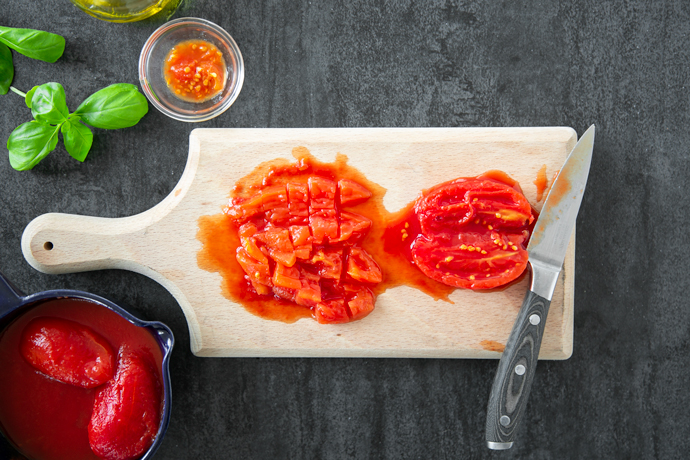
Step 1 - Prepare the Tomatoes.
Start by slicing in half your canned tomatoes lengthwise.
Remove as many seeds as possible, then chop the tomatoes into small chunks and set aside.
Don't throw the juice in the cans away, as you will need it later.
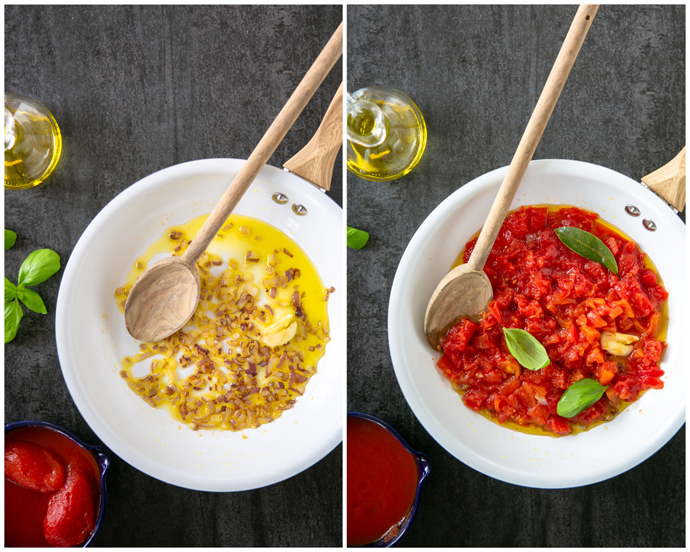
Step 2 - Stir-fry The Veggies.
Heat the olive oil in a large frying pan ( alternatively, you can opt for a cast-iron pot too).
Add in the onion and garlic and cook for a couple of minutes.
Then add chopped tomatoes, basil leaves and the bay leaf.
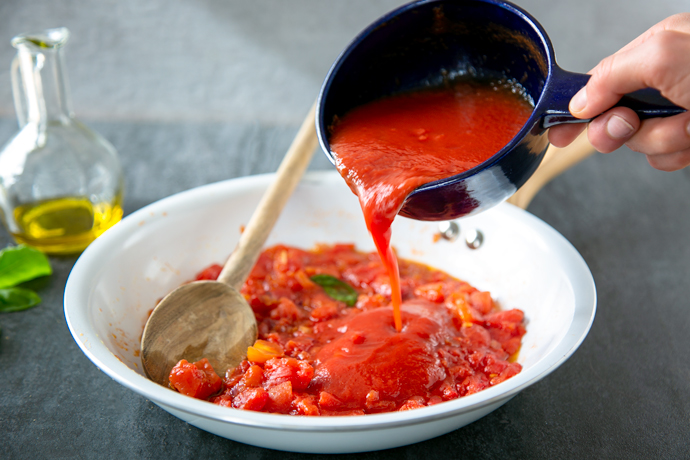
Step 3 - Add the Tomato Juice.
Add into the pan the reserved tomato juices from the cans and some extra water.
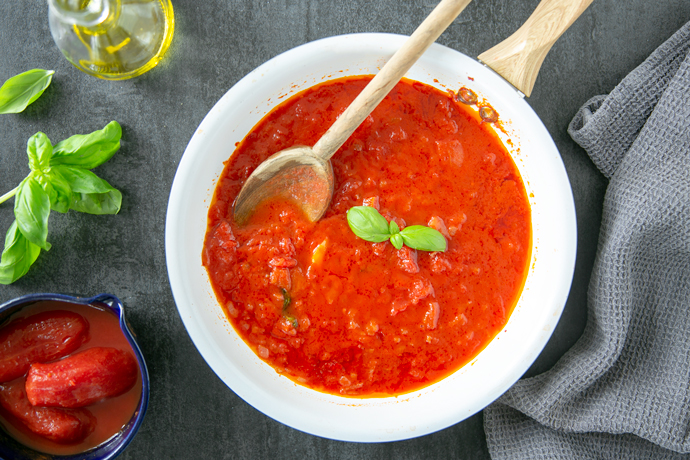
Step 4 - Let the Sauce Cook.
Simmer gently over low heat for about 20 minutes, stirring occasionally with a wooden spoon.
Once it's ready, season with sea salt and freshly-cracked black pepper to taste.
Now, cook some pasta al dente, set the table and grate some awesome Parmigiano.
Fold the pasta into the sauce, serve, top with cheese and enjoy every single bite!
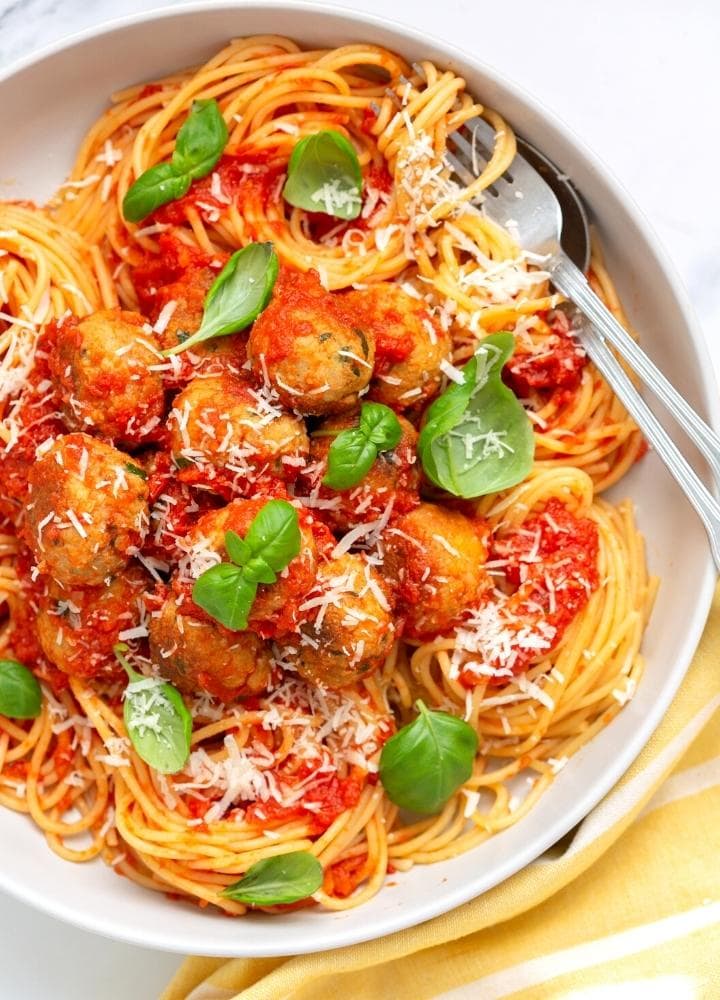
RECIPE FAQs
In most cases what makes the sauce bitter is the tomato itself.
Canned tomatoes are usually more bitter than fresh ones, so here are a couple of tricks Italian nonnas use to take the bitterness out.
Add a bay leaf into the sauce whilst it simmers, it will give your sauce the perfect sweetness balance. If you don't have bay leaf at hand, add a pinch of sugar.
Make sure you remove as many seeds as you can from the tomatoes, as they also add bitterness to the sauce.
Try to use ceramic-coated pans or cast iron pans, because aluminum-coated pans may leave a metallic acidic taste to your sauce.
Store the leftover sauce in an airtight jar, in the fridge for up to 1 week. Or freeze in freezer-friendly containers for up to 6 weeks.
HOW DO YOU SERVE TOMATO SAUCE?
This is the only basic red sauce you'll ever need in your life.
It's conveniently vegetarian, dairy-free, vegan and gluten-free, and a great base for so many meaty and vegetarian Italian dishes. Here are a few serving suggestions:
- Pasta: use it as a base for many traditional pasta recipes such as Sicilian eggplant spaghetti sandwiches, shrimp linguine and Sicilian Pasta alla Norma.
- Meatballs: serve it with chicken meatballs, polpette (Italian meatballs), polpettone, lasagne, or any other pasta you fancy.
- Fish: poach white fish fillets (such as cod, halibut and seabass) directly in the sauce. You can add olives, bell peppers, or capers for extra flavor.
- Eggs: poach the eggs in the sauce to make the popular Italian dish "eggs in purgatory".
DID YOU TRY THIS RECIPE?
Please let me know how you liked it! Leave a comment below and share a picture on Instagram with the hashtag #thepetitecook!
Looking at your pictures always makes me smile *and super hungry*!
Recipe
Authentic Italian Tomato Sauce
Ingredients
- 2 cans organic whole plum tomatoes, (400gr each)
- 2 tablespoon extra-virgin olive oil
- 1 medium-small red onion, finely minced
- 1 garlic clove, gently crushed (optional)
- 4 fresh basil leaves
- 1 bay leaf, or a pinch of sugar
- sea salt and black pepper to taste
Instructions
- Cut each whole canned tomato in half, remove seeds and juice, roughly chop into chunks, and set aside. Set aside any remaining sauce in the cans.
- Heat a medium pan with the extra-virgin olive oil and the garlic (if using) over medium-low heat.
- Add in the onion, and gently stir-fry it together with the garlic for about 5 minutes. Cook until the onion is translucent and the garlic golden, then add in the tomatoes. Depending on your taste, discard the clove at this stage or when the sauce is cooked.
- Add in a couple of basil leaves and a bay leaf (or a pinch of sugar), season with sea salt and freshly-cracked black pepper to taste, and gently cook all the ingredients for a further 5 minutes.
- Pour in the reserved juices from the cans. Add ⅓ cup (80 ml) of water in one of the cans, and pour it over the sauce.
- Cover the pan with a lid, and cook over medium-low heat for about 15 minutes, stirring occasionally.
- The sauce is ready when it reaches a nice creamy but still chunky texture, and has just the right balance of sweetness and savoury when you taste it.
- Remove the sauce from the heat, add in the remaining fresh basil leaves, adjust seasoning if necessary, and serve with your favourite pasta.
Video
Notes
Nutrition
The information shown is an estimate provided by an online nutrition calculator. It should not be considered a substitute for a professional nutritionist’s advice.








Jamie Allport says
This recipe looks great. Simple ingredients. I have an abundance of late tomatoes and have been looking for a sauce to can. Have you canned this before? Just wondering how it holds up.
Thank you
Beverly Lo Tempio says
My grandmother would use her fresh canned tomatoes w/glove of garlic and basil. However she made a whole pot full and often cooked meatballs, sausage, ribs and sometimes lamb in the sauce. She added a little sugar. Was that a different kind of sauce?
Julie Bright says
Hello, I’m about to harvest lots of tomatoes, can you tell me what quantity I will need to reproduce your recipe. Many thanks.
Christen says
This is so good and easy !
I used fresh tomatoes and basil . Put it on zoodles . Mmm
Theresa says
I just wanted to share that I have been using this recipe for years now! It comes out perfect each time and I know it by heart. <3
I love how fresh it tastes and simple it is to make.
Thank you so much for sharing! 🙂
Andrea says
Thank YOU so much Theresa, so happy to hear that!!!
Robert says
I prepared this exactly as written with canned San Marzano tomatoes. It reminded me of my Italian grandmother's sauce. I had to resist the temptation of "adding" and "doctoring" and I am very glad I resisted. The simplicity of this sauce and the amazing taste are surprising. Thank you so much!!!!!!!!
Sonia Gano says
Hi! I am planning on making this sauce tomorrow and I was wondering in letting it cook longer would hurt the flavor?
Andrea says
Hi Sonia, I don't recommend overcooking the tomato sauce, the less the better!
Erin says
Do you chop the basil before putting it in the sauce?
Andrea says
Hi Erin, I don't chop the basil, I just add a couple of basil leaves to flavor the tomato sauce.
Dee Sterling says
Do you use the juice & seed from the chopped tomatoes too? Or just the juice left in the can?
Andrea says
Hi Dee, as explained in the post, I like to remove the seeds as they're quite bitter, use both the juice from the can and from the chopped tomatoes 🙂
Dee Sterling says
Hi again I missed the seed step in article and you can freeze any leftover sauce. But can you also water bath can the sauce too? I have a lot of garden tomatoes and need to do a sauce or something instead of going to waste. Thank you.
Andrea says
Hi Dee, no worries! I do often freeze the sauce. You can freeze tomato sauce in freezer-friendly containers for up to 3 months. You can also can prepared tomato sauce in a water bath.
Leonida Savell says
articolo perfetto grazie
Morgan says
I made this recipe last night and we enjoyed it! The only thing was the onion was a little overpowering. I used a red onion as the recipe says, but when I came back to look through the whole page the onion in your picture looks more like a shallot. So, just to clarify for the future, do you use a red onion or a shallot?
Andrea says
Hi Morgan! I use red onions to make tomato sauce. There are lots of red onion varieties out there, some with a more overpowering flavor than others. My advice for the next time is to finely chop the onion and let it sit for 15 minutes in a little bowl with cold water and ice, then drain, pat dry and proceed with the recipe. This should help cut down the flavor.
Matt Ellis says
Try cooking the onion for longer. Almost to the point of caramelisation. It’ll add a rich sweetness.
Jane C says
I havn't got any fresh basil, can I use dried?
Have made this recipe loads of times with fresh, really lovely.
Andrea says
Hi Jane, thank you for your feedback! I don't really use dried basil, so I'm not sure about the outcome. If you don't have fresh basil you can substitute it with a bay leaf, at least, that's what I do :)!
Paul says
Nice recipe, never tried a bay leaf, always sugar. But will use bay leaf next time. Thank you
Lizzie says
I’ve just made this with a variety of tomatoes from the green house - plum, cherry and beefsteak. It was delicious. My 15yr old is a pomodoro pasta lover and this is her first choice when eating out. She gave it a high rating!! Now on second batch for the freezer. I added a splash of red wine as well - delicious.
Lisa says
How much sauce does this make?
Andrea says
Hi Lisa, it makes about 1 + 1/2 cups of sauce, enough to mix with pasta and feed 4 people.
Kristine Witscher says
Thanks so much! I will be giving this a try tonight!
Kristine Witscher says
Question. If I am using fresh tomatoes rather then canned, I will not have the extra liquid from cans to add to the sauce. Should I be using additional water to replace the juice from the cans?
Andrea says
Hi Kristine! If you use fresh tomatoes, I recommend first blanching them for a minute or two (so you can easily remove their skins), then you can follow the recipe and substitute the canned tomato juice with lukewarm or hot water. Here's a helpful tutorial on
how to peel tomatoes.De Reiger says
I'm glad that you shared this recipe to us,easy to cook and taste so good.
Doug says
In step 3 you remove the garlic clove so I assume that "gently crushing" leaves the clove in one piece. Do I have this right?
Andrea says
Hi Doug, yes, exactly! You need to be a little careful when crushing the clove, so that it remains in one piece and its flavor is not overpowering.
Millie says
Going to make this tonight! Is it okay to let the sauce cook for a few hours ? Or is that not necessary?
Andrea says
Not necessary at all, I find that 20-25 min max is the best time 🙂
Luna says
I'm so glad it doesn't seem so hard to make the sauce. Thank you for sharing the recipe!
Emma says
This sauce sounds amazing, so flavourful. I shall definetly give it a try as I am always looking for a great tomato sauce.
Andrea ThePetiteCook says
Thank you! It's definitely my favourite sauce EVER 🙂
Barbara Wachter says
Do you not use the juice from the tomatoes just add water to the can once you remove the tomatoes? Wouldn't that give he sauce extra flavor? Just wondering. Thanks.
Andrea ThePetiteCook says
Hi Barbara, yes you're absolutely right! I often use the tomato juice as well, I've edited the recipe to make it more clear!